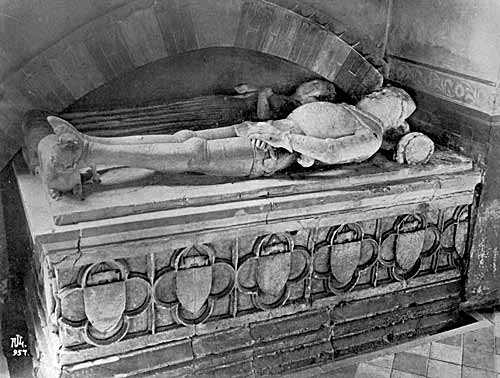< Holme Pierrepont | Contents | Nuthall >
St. Michael's, Hoveringham.
 ARMS OF GOUXHILL—Barry of six or and azure,
a canton ermine.
ARMS OF GOUXHILL—Barry of six or and azure,
a canton ermine.THE venerable old Church at Hoveringham was pulled down in 1865, and a new structure of red brick with a slate roof now stands upon the site. Mercifully the Norman tympanum and the Gouxhill Tomb were preserved, but the tracery from the Decorated Windows went to embellish the gardens of the adjoining villas. The Gouxhills or Goushills were owners in Hoveringham previous to the reign of King John and continued to be so until the early years of the fifteenth century, when their property passed to others, through failure of a male heir.
The double alabaster table tomb of Sir Robert Gouxhill and his wife originally occupied a place in the south transept of the old Church. It was moved at the time of the above wanton demolition and mutilated in order to coerce it into the arched recess where it now abides, placed north and south. It bears on the slab the recumbent effigies of Sir Robert Gouxhill and his wife (married 2 Henry IV), Elizabeth, daughter and heir of the Earl of Arundel (who was beheaded for treason 1397) and widow of Sir Thomas Mowbray, Earl of Nottingham, who was created, previous to his marriage with this lady, first Duke of Norfolk. Oddly enough Sir Thomas Mowbray was one of the chief witnesses against the Earl of Arundel, whose daughter he subsequently married!
 Tomb of Sir Robert Gouxhill (1403), Hoveringham
church.
Tomb of Sir Robert Gouxhill (1403), Hoveringham
church.On the Knight's head, which rests upon his crested helmet, is a bascinet with a wreath; he wears the camail, jupon, laminated solleretts, and armour on his arms and legs; round his neck is an S.S. collar; an elaborate hip belt supports his sword, which is now broken away, and by his right side is his misericorde dagger, also broken; at his armpits and below the quainted edge of his jupon may be detected his hauberk of mail. In his left hand he holds his dexter gauntlet and doubtless originally he was represented holding his wife's hand, but the right arms of both have gone. By his right side lies the effigy of his wife in a long robe, possibly a peeress' mantle, fastened at the breast with a morse or clasp and pendant; on her head, which reposes on a cushion, is a coronet denoting her rank. The Gouxhill crest is very similar to that of the Strelleys, viz., a Moor's head couped proper.
There are neither arms or inscription now to be seen on the tomb, which, as already stated, has suffered by being moved and reconstructed. The shields on the panels were originally emblazoned with the arms of Leek, Langford, Babington, Chaworth impaling Caltofts, Rempstone and others (Thoroton), but the pigments have long since disappeared.
This Sir Robert Gouxhill met his death at the Battle of Shrewsbury (21 July, 1403), fighting for King Henry IV, when he was badly wounded and then treacherously killed by his servant. He left no son and his property passed away to his two daughters, who married Sir Robert Wingfield and Baron Stanley respectively. In this way the connection of the Gouxhill family with Nottinghamshire ceased. A village tradition is that the Gouxhill crest of a Moor's head represents the knight's infamous servant.
The property and presentation of the living now rests in Trinity College, Cambridge.
![]()
< Holme Pierrepont | Contents | Nuthall >
